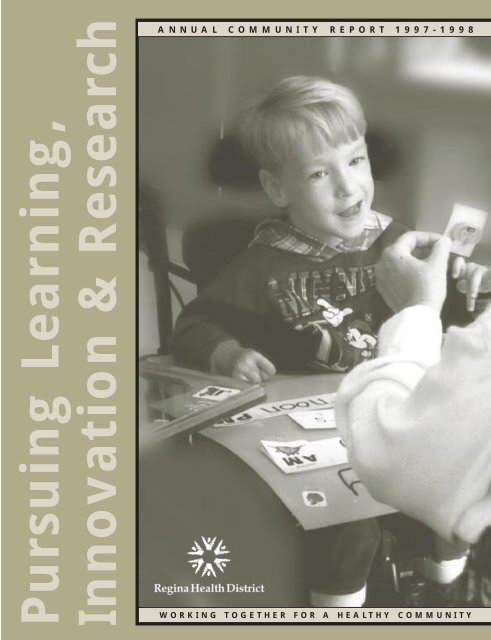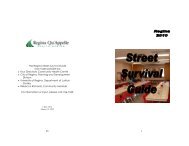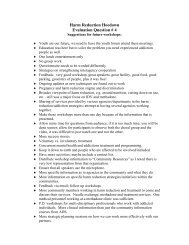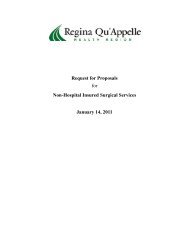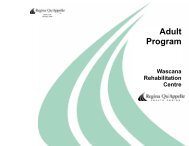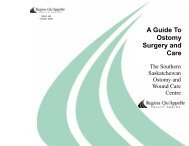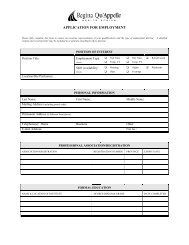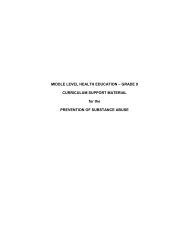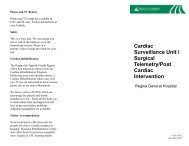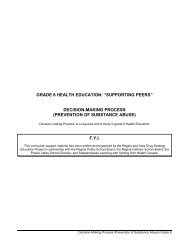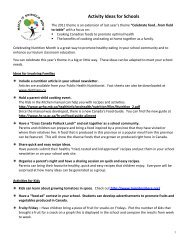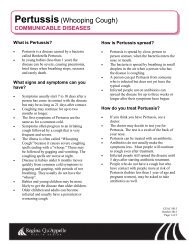pdf file format - Regina Qu'Appelle Health Region
pdf file format - Regina Qu'Appelle Health Region
pdf file format - Regina Qu'Appelle Health Region
You also want an ePaper? Increase the reach of your titles
YUMPU automatically turns print PDFs into web optimized ePapers that Google loves.
Pursuing Learning,<br />
Innovation & Research<br />
ANNUAL COMMUNITY REPORT 1997-1998<br />
WORKING TOGETHER FOR A HEALTHY COMMUNITY
A Year of Pursuing Learning, Innovation & Research<br />
A Message from the Chairperson<br />
and the Chief Executive Officer<br />
The year 1997-1998 was a challenging one for the <strong>Regina</strong> <strong>Health</strong> District.<br />
Throughout all the changes in work practices and work places, your health<br />
care delivery and support team continued to learn and to grow.<br />
We pride ourselves on being a learning organization. We are constantly<br />
researching and acting on ways to make things better for our clients, residents<br />
and patients.<br />
All of us who work within the <strong>Regina</strong> <strong>Health</strong> District took pride this year in<br />
having the District held up as a model for all of Canada in the way we deliver<br />
integrated, client-centered care. The<br />
learning that went on through this<br />
accreditation process continues to<br />
make us better at what we do for you.<br />
Garf Stevenson and Glenn Bartlett review<br />
floorplans as new construction nears<br />
completion at the <strong>Regina</strong> General Hospital<br />
We learn as an organization but we<br />
also teach. Medical students from the<br />
University of Saskatchewan’s College<br />
of Medicine trained here throughout<br />
the year. The District also provided<br />
experience to students in other<br />
programs, in cooperation with<br />
educational institutions across<br />
Canada.<br />
Research and learning lead to innovation. Sometimes these innovations are<br />
on a large scale. The <strong>Regina</strong> <strong>Health</strong> District is recognized as unique in the<br />
country in having developed a completely coordinated approach to ensuring<br />
that our clients and patients are given the care they need, when and where<br />
they need it.<br />
The human touch is critical to the work of the <strong>Regina</strong> <strong>Health</strong> District. It is as<br />
vital to us to develop small innovations – such as lunch choices for patients in<br />
palliative care – as it is to create innovative systems to coordinate care.<br />
Ultimately, all lives are lived one day at a time. The quality of the care we give<br />
each day, and the compassion, understanding, and support we demonstrate to<br />
those in need, are the ultimate tests of whether our pursuit of learning,<br />
innovation and research has meaning.<br />
Table of Contents<br />
3 • Strategic Framework<br />
4 • Goals<br />
8 • Learning<br />
10 • Innovation<br />
12 • Research<br />
14 • Boundaries<br />
& Population Served<br />
16 • Services Offered<br />
18 • Organization<br />
& Leadership<br />
20 • Financial &<br />
Staffing Highlights<br />
21 • Statistical Review<br />
24 • Facilities & Services<br />
For further in<strong>format</strong>ion regarding<br />
material presented in the Annual<br />
Community Report, please contact<br />
the <strong>Regina</strong> <strong>Health</strong> District Public<br />
Affairs Department.<br />
PHONE<br />
(306) 766-5365<br />
FAX<br />
(306) 766-5414<br />
MAIL<br />
2180 - 23rd Avenue,<br />
<strong>Regina</strong>, SK S4S 0A5<br />
E-MAIL<br />
publicaffairs@reginahealth.sk.ca<br />
WEBSITE<br />
www.reginahealth.sk.ca<br />
Garf Stevenson<br />
Chairperson<br />
<strong>Regina</strong> District <strong>Health</strong> Board<br />
Glenn S. Bartlett<br />
President & Chief Executive Officer<br />
<strong>Regina</strong> <strong>Health</strong> District<br />
COVER PHOTO:<br />
Paige Rorbeck pursuing learning at<br />
Wascana Rehabilitation Centre School.<br />
© Copyright 1998 <strong>Regina</strong> <strong>Health</strong> District<br />
2<br />
<strong>Regina</strong> <strong>Health</strong> District
The <strong>Regina</strong> <strong>Health</strong> District’s<br />
STRATEGIC<br />
FRAMEWORK<br />
Our Mission<br />
Working Together for a <strong>Health</strong>y Community<br />
The <strong>Regina</strong> <strong>Health</strong> District provides a comprehensive array of health<br />
services to its residents, and, through the provision of unique and<br />
specialized services, supports the health care needs of southern<br />
Saskatchewan.<br />
Our Goals<br />
Client-Centered Service<br />
• Provide accessible, holistic and<br />
culturally sensitive services that<br />
facilitate informed client choices.<br />
Integrated Services<br />
• Improve service delivery.<br />
Our Values<br />
Success will be achieved through commitment<br />
to our shared values.<br />
Respect<br />
All relationships, decisions and<br />
actions will be guided by<br />
honesty and fairness.<br />
Caring<br />
An attitude that is reflected in<br />
everything we do.<br />
Our Vision<br />
• delivering client-centered<br />
services that are accessible and<br />
responsive to the changing<br />
needs of our community.<br />
Participation<br />
Everyone has a role to play in<br />
building a healthy community.<br />
The <strong>Regina</strong> <strong>Health</strong> District will promote a<br />
healthier community by:<br />
Continuous Improvement<br />
Improvement will be guided<br />
by personal and organizational<br />
learning and growth.<br />
• creating an environment<br />
that fosters individual<br />
responsibility, teamwork<br />
and client satisfaction.<br />
Client Satisfaction<br />
• Improve our clients’ perception<br />
of our organization and service.<br />
Individual Responsibility<br />
and Teamwork<br />
• Promote health.<br />
• Promote individual responsibility<br />
and teamwork within our<br />
organization.<br />
Learning, Innovation<br />
and Research<br />
• Continuously improve our care<br />
and service through ongoing<br />
personal and organizational<br />
learning and growth.<br />
Needs-Based Services<br />
• Reduce inequities in health.<br />
• Prevent disease.<br />
• Create a healthy environment.<br />
• Encourage behaviours that<br />
support health.<br />
• Improve health services.<br />
• being a leader in the provision<br />
of integrated health services.<br />
• pursuing learning,<br />
innovation and research.<br />
Annual Community Report 1997-1998<br />
3
Working to reach our<br />
DISTRICT<br />
GOALS<br />
The <strong>Regina</strong> <strong>Health</strong> District<br />
aims to improve,<br />
continuously, the care and<br />
service it provides.<br />
It does this through<br />
ongoing learning, both for<br />
staff and for the<br />
organization as a whole.<br />
Ongoing learning guides the<br />
District to its goals in many<br />
ways. The District studies<br />
the outcomes of client care<br />
and audits the use of<br />
services, so it knows where<br />
to make improvement. The<br />
District also compares its<br />
performance with other<br />
health care organizations,<br />
striving to put in place the<br />
best practices in Canada. As<br />
well, at any given time,<br />
staff and professionals in<br />
the District have many<br />
ongoing research projects<br />
that will, ultimately,<br />
improve the care and<br />
service provided to clients.<br />
On these pages are some<br />
examples of how the<br />
District is reaching its goals<br />
through learning,<br />
innovation and research.<br />
4<br />
<strong>Regina</strong> <strong>Health</strong> District<br />
Client-Centered Service<br />
“You are very focused on your clients”<br />
After visiting with staff and clients at <strong>Regina</strong> <strong>Health</strong> District sites in June<br />
1997, the survey team from the Canadian Council on <strong>Health</strong> Services<br />
Accreditation spoke to District board members and employees about their<br />
findings.<br />
Ruth Duffy, one of the surveyors, said that often staff are at the top of an<br />
organization and clients are at the bottom, but that’s not the case in this<br />
district.<br />
“We really felt that, after a week and a half with you, you have inverted this<br />
pyramid, this triangle, and, in fact, your clients are most important. We<br />
saw this everywhere we went. You are very focused on your clients . . . and<br />
everything else exists in support of those clients.”<br />
Duffy said that during its review, the Council saw approaches that are<br />
trend-setting for Canada.<br />
“I believe that this senior management team and Board, and, in fact, this<br />
organization, is really about to say to the rest of the country, ‘Look at us.<br />
This is the way to grow an integrated service delivery system in health care.<br />
Look at us, we’re the role model. We can show you how it’s supposed to be<br />
done.’ All of us will be watching and know you can do it.”<br />
Helping Our Youngest Clients<br />
Mothers and their newborns are now<br />
receiving more help with breastfeeding<br />
in the maternity area of the <strong>Regina</strong><br />
General Hospital.<br />
The <strong>Regina</strong> <strong>Health</strong> District surveyed new<br />
mothers in June 1997. The mothers said<br />
that they would have liked more<br />
consistent advice about breastfeeding,<br />
which is the best method of infant<br />
feeding.<br />
As a result, the District hired lactation<br />
consultants or breastfeeding specialists.<br />
The lactation consultants have two roles.<br />
They teach nurses about breastfeeding<br />
and provide guidelines to follow so that<br />
nurses are better able to help mothers<br />
and newborns. They also help the moms<br />
and babies who are having more serious<br />
problems.<br />
The District plans to continue surveying<br />
new mothers with the goal of learning<br />
how best to promote breastfeeding.<br />
Research resulted in improved service for<br />
mothers and newborns
Integrated Services<br />
Education Precedes Integration<br />
In the <strong>Regina</strong> <strong>Health</strong><br />
District, construction and<br />
renovation are making<br />
room to bring together<br />
hospital services, add new<br />
programs, and provide<br />
sophisticated new medical<br />
equipment for clients.<br />
The District’s goal is<br />
integrated services to<br />
enhance the health care<br />
provided to clients.<br />
One of the services to be<br />
integrated at the <strong>Regina</strong><br />
General Hospital is<br />
cardiosciences, which<br />
includes coronary care,<br />
cardiac surveillance and<br />
cardiac diagnostic units.<br />
While the new area was<br />
under construction, the<br />
District’s Education and<br />
Development Services<br />
Department brought<br />
cardiosciences<br />
staff together to make<br />
plans. In eight focus-group<br />
sessions, the 150 staff<br />
members discussed<br />
delivery of patient care,<br />
how the new unit will<br />
function, staff care,<br />
clarification of roles, and<br />
managing the move.<br />
As well, Clinical<br />
Development Educators<br />
updated the staff’s clinical<br />
skills, taught them how to<br />
manage the unit’s new<br />
equipment, and orientated<br />
them to their new site.<br />
The <strong>Regina</strong> <strong>Health</strong> District<br />
recognizes that integrating<br />
services is not as easy as<br />
putting hospital staff and<br />
equipment together in one<br />
location. The vital task of<br />
educating staff must be<br />
done before moves take<br />
place.<br />
The SWADD Study<br />
In order to achieve the goal of integrated services, the<br />
<strong>Regina</strong> <strong>Health</strong> District reorganized services and introduced<br />
the System Wide Admission and Discharge Department<br />
(SWADD).<br />
SWADD was developed to ensure patients receive the best<br />
care possible. By having one department look after all<br />
admissions and discharges in the health care system, the<br />
District will improve access, coordination, continuity,<br />
communication and discharge processes.<br />
SWADD is a unique approach in Canadian health care, so<br />
it’s crucial to evaluate its impact systematically.<br />
During 1997 and 1998, the District gathered in<strong>format</strong>ion<br />
for a comprehensive study of the new department. The<br />
study will examine the effectiveness of SWADD in<br />
improving quality of care, access of patients to care,<br />
integration of services, health outcomes, and costs.<br />
The evaluation of SWADD goes beyond simply measuring<br />
its effectiveness. The study will also attempt to identify for<br />
which groups of patients and for what particular services<br />
SWADD works best.<br />
Client Satisfaction<br />
The District’s goal is to deliver client satisfaction<br />
Survey Tracks Client Satisfaction<br />
Research conducted in the <strong>Regina</strong> <strong>Health</strong><br />
District has shown that nine out of ten<br />
patients are highly satisfied with the care<br />
and service they received in hospital.<br />
The client survey was conducted in 1997<br />
by the Conference Board of Canada,<br />
which was invited by the District to do the<br />
research. The purpose of the research was<br />
to improve service to clients.<br />
The survey asked 1,800 clients about their<br />
hospital experiences, tracking their<br />
opinions on the different programs and<br />
services they received.<br />
An indicator called “total satisfaction” was<br />
developed to measure the combined<br />
results of answers to three separate<br />
questions. The questions related to client<br />
satisfaction with quality of care, the<br />
likelihood that clients would want to<br />
return to that site for treatment, and how<br />
they would describe the care they received<br />
to friends and relatives.<br />
Ninety-two percent of the clients surveyed<br />
said they were very highly or highly<br />
satisfied with the care and service they<br />
received in <strong>Regina</strong> <strong>Health</strong> District<br />
hospitals.<br />
Annual Community Report 1997-1998<br />
5
Individual Responsibility & Teamwork<br />
Working for a healthy smile<br />
Toothaches hurt, and, if the problem<br />
is serious, they’re expensive to treat.<br />
That’s why Public <strong>Health</strong> nurses with<br />
the <strong>Regina</strong> <strong>Health</strong> District designed<br />
a new program to prevent children<br />
from getting dental disease.<br />
They launched a program to get<br />
children at the Public School Board’s<br />
Early Learning Centre, and their<br />
families, to brush their teeth. They’re<br />
hoping it develops into a habit that<br />
will last a lifetime.<br />
The program got under way with a<br />
lot of help from teachers and a grant<br />
from Saskatchewan <strong>Health</strong>.<br />
Public <strong>Health</strong> Services developed the<br />
program after research showed that<br />
more than one third of the children<br />
at the Early Learning Centre already<br />
had problems with their teeth. That’s<br />
about 10 times more than the<br />
provincial average.<br />
The preschoolers brush their teeth<br />
twice a day at school. To encourage<br />
parents to take responsibility for<br />
dental care at home, the District<br />
supplies a dental care pack and<br />
teaches family members how to<br />
brush their teeth and why it’s<br />
important.<br />
The preschool dental project<br />
supports the District’s goal of<br />
encouraging individual responsibility<br />
for health while working in<br />
partnership with others in the<br />
community.<br />
Learning, Innovation & Research<br />
Providing Education and Experience<br />
The <strong>Regina</strong> <strong>Health</strong> District is more than a provider of health care<br />
services.<br />
The District is a teaching organization, providing hands-on experience<br />
to more than 100 students every year. This is done in partnership with<br />
universities and secondary education institutions across Canada.<br />
The learning partnerships are often innovative. A new Nursing Critical<br />
Care Course is being developed by the <strong>Regina</strong> <strong>Health</strong> District,<br />
Saskatoon District <strong>Health</strong> and Saskatchewan Institute of Applied<br />
Science and Technology (SIAST).<br />
In the course, nurses interested in working in critical<br />
care areas such as intensive and cardiac care units first<br />
do theoretical work, then do practical work under the guidance of<br />
skilled critical care nurses.<br />
In addition to nurses, the <strong>Regina</strong> <strong>Health</strong> District teaches researchers,<br />
therapists, pharmacists, dietitians, technologists, pastoral care<br />
providers, clinical psychologists, and administrators.<br />
Students refine their skills and prepare themselves for independent<br />
practice by working alongside competent, experienced professionals<br />
as they deliver care and services to our clients.<br />
The District provides learning and work experiences for co-op<br />
university students from across Canada in Engineering,<br />
Administration, Science, and Master of Business Administration<br />
(MBA) courses. The students are paid and work as employees during<br />
the four to eight-month-long work terms, which are part of their<br />
university curriculum.<br />
Researching the Facts<br />
Evidence-based medicine is<br />
about making decisions based on<br />
the facts, not on personal beliefs<br />
or guesswork. To come up with<br />
the factual basis for decision<br />
making, the <strong>Regina</strong> <strong>Health</strong><br />
District conducts scores of<br />
research studies each year.<br />
In 1997, the District’s Clinical<br />
Research and Development<br />
Program completed a study on<br />
those waiting for cataract<br />
surgery. Useful judgments on<br />
waiting periods for elective<br />
surgery require a good<br />
understanding of how waiting<br />
does – or does not – affect the<br />
outcomes for our patients.<br />
A group of 98 patients scheduled<br />
for cataract surgery, and their<br />
doctors, provided in<strong>format</strong>ion<br />
both before and after surgery.<br />
On average, patients waited just<br />
over 73 days for their surgery.<br />
Researchers asked how patients<br />
were coping. They wanted to<br />
find out if there were any<br />
difficulties in functioning,<br />
emotional distress associated<br />
with the wait, or any adverse<br />
effects on vision.<br />
The results of the research were<br />
very encouraging. Patients<br />
voiced little concern about the<br />
waiting period. Difficulties with<br />
visual and emotional functioning<br />
while waiting were rare, and<br />
slight when they did occur.<br />
Overall, the study on those<br />
waiting for cataract surgery<br />
showed that the waiting period<br />
did not have a negative impact<br />
on the outcome of the surgery.<br />
The District is encouraging individual<br />
responsponsibilty for health
Needs-Based Services<br />
Improving Service Through<br />
Research<br />
By doing research, the District gets<br />
an accurate and detailed picture of<br />
current services. This identifies<br />
opportunities to improve service<br />
and better meet patient needs.<br />
Every aspect of Operating Room<br />
(OR) services was examined in<br />
detail in 1997 as the <strong>Regina</strong> <strong>Health</strong><br />
District conducted an OR audit.<br />
The study collected detailed<br />
in<strong>format</strong>ion about utilization,<br />
processes, efficiencies and outcome<br />
of Operating Room services<br />
throughout the District.<br />
Many changes will be made as the<br />
District integrates and consolidates<br />
services at the <strong>Regina</strong> General and<br />
Pasqua Hospitals. The ultimate goal<br />
of integration in the District is to<br />
improve services. The OR audit will<br />
help physicians and staff make<br />
recommendations about how to<br />
increase the efficiency of OR<br />
services to meet the needs<br />
identified through the audit.<br />
Meeting the Needs of Patients<br />
Who Attend ER<br />
More than 100,000 patients go to<br />
emergency departments within the<br />
<strong>Regina</strong> <strong>Health</strong> District each year. They<br />
go for many different reasons – not all<br />
of them urgent.<br />
So what do the patients need? The<br />
<strong>Regina</strong> <strong>Health</strong> District did some<br />
research into that question in order to<br />
design a service to fit patients’ needs.<br />
While most visits to the Emergency<br />
Room (ER) are not planned, some are<br />
scheduled. These scheduled visits are<br />
for appointments made between<br />
doctors and patients.<br />
The Emergency Room Audit Task<br />
Force found that half of all ER cases in<br />
the District are not urgent. Fully 80%<br />
of scheduled visits were found not to<br />
be urgent.<br />
The Task Force recommended that<br />
non-urgent cases be redirected to<br />
Operating Room services were studied in detail in 1997<br />
ambulatory care areas, thus freeing the<br />
ERs for urgent cases.<br />
In response to the research findings,<br />
the District is developing new<br />
ambulatory care clinics at the Pasqua<br />
and <strong>Regina</strong> General hospitals.<br />
Ambulatory care can handle many of<br />
the non-urgent, scheduled treatments<br />
and consultations previously dealt<br />
with in the ERs. These include such<br />
procedures as cast removal and minor<br />
surgery.<br />
Having these procedures done in<br />
ambulatory care areas allows true<br />
emergency cases to be attended to<br />
more quickly and efficiently in the<br />
ERs.<br />
Using thorough research, the <strong>Regina</strong><br />
<strong>Health</strong> District works to understand<br />
patient needs. A sound understanding<br />
of these needs allows the District to<br />
continue to create better ways to<br />
meet them.<br />
Reaching<br />
Our Goals<br />
Through<br />
Learning,<br />
Innovation<br />
& Research<br />
Annual Community Report 1997-1998<br />
7
LEARNING<br />
Learning is on-going in the <strong>Regina</strong> <strong>Health</strong> District, encompassing education for medical professionals<br />
and staff, and the entire organization. The District is dedicated to continuous learning in order to<br />
improve client care and service.<br />
A Partnership for Children<br />
Describing a typical day at Wascana Rehabilitation Centre School is<br />
like describing the wind — always moving and changing.<br />
In other words, there is no “typical”<br />
day. The schedule is flexible and<br />
changes so that children attending<br />
the school can receive both intensive<br />
rehabilitation therapy and their<br />
education.<br />
Each child’s program is a collaborative<br />
effort, involving families, teachers and<br />
therapists, focusing on learning as well<br />
as treatment.<br />
students ages three through 22, in a<br />
combination of classroom<br />
instruction and individual tutorials.<br />
The children are referred for<br />
placement in the school by the<br />
Children’s Program team.<br />
Children attend the school<br />
for a short-term period of<br />
assessment, therapy and program<br />
planning in order to facilitate<br />
educational placement within<br />
their communities.<br />
Once the children leave the<br />
Wascana Rehabilitation Centre<br />
School to attend other educational<br />
programs, professional staff from<br />
the Children’s Program continue to<br />
consult with families and<br />
educational personnel in order to<br />
best meet the children’s needs.<br />
During the school day, the children<br />
are involved in a variety of therapy<br />
programs to meet their individual<br />
needs. When they are not in therapy,<br />
the children are in class working with<br />
the teachers and support staff toward<br />
their own educational goals.<br />
Learning is a priority for the children<br />
in the school, despite each child’s<br />
significant therapy needs.<br />
The Wascana Rehabilitation Centre<br />
School is a <strong>Regina</strong> Public School<br />
working in cooperation with the<br />
<strong>Regina</strong> <strong>Health</strong> District Wascana<br />
Rehabilitation Centre Children’s<br />
Program. This school is one of the<br />
<strong>Regina</strong> Hospital Schools that<br />
includes classrooms at the General<br />
and Pasqua hospitals, serving<br />
students in acute care on both the<br />
Pediatric and Adolescent units.<br />
The Wascana Rehabilitation Centre<br />
School offers programming for<br />
Children work with therapists and teachers at Wascana Rehabilitation Centre School<br />
8<br />
<strong>Regina</strong> <strong>Health</strong> District
Continuous Learning<br />
Opportunities<br />
In health care, the only constant is<br />
change. Every day, new equipment,<br />
drugs and treatments are being<br />
developed.<br />
In the <strong>Regina</strong> <strong>Health</strong> District, it’s the<br />
job of Education and Development<br />
Services to keep staff up to date with<br />
change. A team of educators provides<br />
programs to update employees’<br />
clinical and communication skills.<br />
The District’s 28 Clinical Development<br />
Educators are specialists in their<br />
areas. They keep staff current in new<br />
practices and help with future<br />
Teaching the Next Generation of Doctors<br />
Dedicated to learning, the <strong>Regina</strong> <strong>Health</strong> District is a partner in<br />
educating more than 60 medical students and residents each year<br />
from the University of Saskatchewan’s College of Medicine.<br />
The university’s largest program in<br />
the District is the <strong>Regina</strong> Division of<br />
the Department of Family Medicine.<br />
The 24 family medicine residents get<br />
experience in different areas of the<br />
hospital during their first year. In<br />
their second year, they spend most of<br />
their time within the Family<br />
Medicine Unit or in a rural site<br />
within the province.<br />
There are second-year medical<br />
students in the College’s Externship<br />
Program. They work in clinics in the<br />
summer months between their second<br />
and third year of medical school.<br />
The College of Medicine operates a<br />
program in the District to provide<br />
clinical experience for students in<br />
their fourth and final year of medical<br />
school. There are also postgraduate<br />
residents receiving education in the<br />
District in specialty programs.<br />
Many of these individuals return to<br />
provide specialty services in <strong>Regina</strong><br />
and for southern Saskatchewan after<br />
the completion of their postgraduate<br />
education. The education<br />
program is, therefore, important in<br />
itself and because it helps supply<br />
primary and specialist services for<br />
southern Saskatchewan.<br />
planning and delivery of care.<br />
Four District Educators strive to keep<br />
staff safe and healthy at work. They<br />
teach programs such as back<br />
management, emergency<br />
preparedness procedures and<br />
orientations for new staff. Four<br />
Education Consultants focus on<br />
leadership development and help<br />
teams plan for the future and work<br />
more effectively together.<br />
College of Medicine programs supply primary and specialist services for southern Saskatchewan<br />
Learning to Reflect the Community<br />
The <strong>Regina</strong> <strong>Health</strong> District’s goal of pursuing<br />
learning looks beyond the classroom to reflect<br />
the distinct cultures in our community.<br />
This goal led the District to form a partnership with<br />
the provincial government Department of<br />
Intergovernmental and Aboriginal Affairs. The<br />
agreement commits the District to developing a<br />
workplace that reflects the diversity of the community<br />
and clients we serve.<br />
Toward that goal, the District formed a partnership with<br />
Dumont Technical Institute and South West Human<br />
Resources to offer a Home Care Special Aide program to<br />
Aboriginal students.<br />
Graduates of the program work for the District’s Home<br />
Care division, which helps people remain independent in<br />
their own homes. Home Care Special Aides learn to work<br />
with people from all cultures and various levels of physical<br />
and mental ability.<br />
Annual Community Report 1997-1998<br />
9
INNOVATION<br />
Innovation means changing the way we think. It means finding better ways – large and small – to serve<br />
our clients, residents and patients. It means going beyond traditional boundaries, or recapturing old<br />
truths, so that all clients feel welcomed and included. It means creating breakthroughs that allow for<br />
better care, delivered more efficiently and effectively, to meet the needs of those we serve.<br />
New Supports for Personal <strong>Health</strong><br />
What does providing computer time to write a resume have to do<br />
with health? Can teaching groups of young mothers how to buy<br />
groceries be called a health care service?<br />
The <strong>Regina</strong> <strong>Health</strong> District has<br />
programs which do both these things<br />
– and more. These programs are<br />
designed to increase a person’s<br />
opportunity for better income, better<br />
skills in coping with the demands of<br />
life, and improved self esteem.<br />
Studies have shown that<br />
improvements in factors such as<br />
these increase a person’s chance for<br />
better personal health.<br />
The <strong>Regina</strong> <strong>Health</strong> District’s<br />
community health centres are<br />
currently involved in programs that<br />
go a step beyond the obvious in<br />
health care promotion. Increasingly,<br />
the focus is turning to areas referred<br />
to as the “determinants of health.”<br />
These determinants involve the<br />
many factors that affect a person’s<br />
life. Included are individual<br />
behaviours, physical environments<br />
(including home, work, school,<br />
community and recreation), as well<br />
as social supports (including family,<br />
friends and community contacts),<br />
income, education, and<br />
employment.<br />
those mothers in improving their<br />
economic situation. Bringing<br />
together unemployed people from<br />
the community to discuss job<br />
interview techniques may allow<br />
them access to employment and<br />
whole new areas of social and<br />
workplace support. Organizing a<br />
feast where community members<br />
can come together to share their<br />
cultural traditions is one way the<br />
District can help build the selfesteem<br />
of those in need.<br />
The range of factors affecting<br />
individual health is vast. The <strong>Regina</strong><br />
<strong>Health</strong> District is working to<br />
integrate services and develop<br />
community partnerships that will<br />
continue addressing the<br />
determinants of health. Above all,<br />
health care in the District will<br />
continue to provide choices that help<br />
individuals and families take control<br />
of factors determining their<br />
own health.<br />
Determinants of <strong>Health</strong><br />
What are the broad determinants of<br />
health, the things which make and<br />
keep people healthy? The following<br />
list was prepared by the Federal,<br />
Provincial and Territorial Advisory<br />
Committee on Population <strong>Health</strong>.<br />
• Income & Social Status<br />
• Social Support Networks<br />
• Education<br />
• Employment & Working Conditions<br />
• Physical Environments<br />
• Biology & Genetic Endowment<br />
• Personal <strong>Health</strong> Practices<br />
& Coping Skills<br />
• <strong>Health</strong>y Child Development<br />
The District has aimed programs<br />
and services at helping individuals<br />
improve these areas. By teaching<br />
young mothers to shop well on a<br />
budget, the District is supporting<br />
Innovative programs go beyond the obvious<br />
in health care<br />
• <strong>Health</strong> Services<br />
Source: Strategies for Population <strong>Health</strong>:<br />
Investing in the <strong>Health</strong> of Canadians,<br />
September 1994<br />
10<br />
<strong>Regina</strong> <strong>Health</strong> District
Native Healing Centres are Unique<br />
Receiving health care in a hospital can be a stressful experience for<br />
anyone. It is even harder if you are not from the majority culture,<br />
speak a language other than English and have different beliefs<br />
about how to deal with your personal well-being.<br />
These are difficulties that can be<br />
faced by Native patients requiring<br />
hospital care.<br />
To respond, the <strong>Regina</strong> <strong>Health</strong><br />
District has initiated Native Healing<br />
Centres – a bold concept, unique in<br />
Canada – to help Native patients feel<br />
more comfortable receiving<br />
treatment.<br />
Under construction at the Pasqua<br />
and General hospitals, the centres<br />
take into account the cultural values<br />
and expectations of Aboriginal<br />
people.<br />
Instead of being built like standard<br />
counselling offices, the centres are<br />
circular, in keeping with the<br />
traditional medicine wheel or circle,<br />
which is an ancient symbol used by<br />
almost all the Native people of North<br />
and South America.<br />
Native counselling services offered at<br />
the centres are designed to reflect<br />
In 1998, however, they formed part of a study about the<br />
well-being of palliative care patients in Pasqua Hospital.<br />
the importance of nature, spirituality,<br />
prayer and the circle. They speak to<br />
the four primary points of the<br />
medicine circle – physical, mental,<br />
spiritual and emotional. They<br />
promote the traditional, humble<br />
way of life.<br />
The centres facilitate healing, prayer,<br />
teaching and other assistance<br />
required to maintain wellness in the<br />
individual and the community.<br />
A key to the healing centres’ concept<br />
is that they be constructed large<br />
enough to accommodate the many<br />
people who gather to support a<br />
member of the family or community<br />
requiring hospital care. They can<br />
meet there to talk with doctors, nurses<br />
and therapists about a client’s case.<br />
Such meetings may take the form of<br />
a traditional Native talking circle,<br />
where all those involved have an<br />
opportunity to express their<br />
The <strong>Regina</strong> <strong>Health</strong><br />
District’s Nutrition and<br />
Food Services started an<br />
innovative home-style meal<br />
service to find out if it<br />
would encourage palliative<br />
care patients to eat better.<br />
The answer was a<br />
resounding “yes.”<br />
The research found that<br />
patients who were able to<br />
choose any of the<br />
attractively presented foods<br />
concerns. A <strong>Regina</strong> <strong>Health</strong> District<br />
counsellor and a Native elder usually<br />
work together to facilitate the talking<br />
circle and to help resolve problems<br />
and issues.<br />
While designed specifically to help<br />
Aboriginal people deal with the<br />
hospital environment, Native<br />
Healing Centre services are available<br />
to all those seeking an alternative<br />
method of healing the physical,<br />
mental, spiritual or emotional<br />
aspects of their lives.<br />
Native Healing Centres help clients cope<br />
Innovation Leads to New Palliative Care Service<br />
China dishes, linen napkins, and bedside buffet service are not usual in a hospital research project.<br />
Choice enhances well-being<br />
from the buffet cart ate better. Eating well is important<br />
because it provides patients with more energy, which may<br />
enhance their feelings of well-being.<br />
A satisfying meal may also improve quality of life at a time<br />
when even the smallest pleasures are important.<br />
The project was so successful that the lunch service is<br />
now offered every day to patients on the nine-bed<br />
palliative care unit in Pasqua Hospital.<br />
The service consists of the sandwiches, soups, and<br />
desserts that are on the regular menu. They are brought<br />
in on a cart, buffet-style, to each patient, who chooses<br />
whatever he or she wants.<br />
Featuring linen napkins, the service provided a touch of<br />
class that family members and patients who participated<br />
in the research sincerely appreciated.<br />
Annual Community Report 1997-1998<br />
11
RESEARCH<br />
Clinical research that aims to improve services for clients begins by asking questions. How do<br />
<strong>Regina</strong> <strong>Health</strong> District programs and services actually operate? Are they efficient? Do they improve<br />
the quality of life? Are clients satisfied? Whether researchers are studying new drugs, the<br />
effectiveness of treatment programs, or factors that underlie specific health conditions, research<br />
in the District is dedicated to improving, continuously, the care and service provided to clients.<br />
Dedicated to Improving Service<br />
Is there room to improve the<br />
services the <strong>Regina</strong> <strong>Health</strong><br />
District provides?<br />
The District’s Section for Clinical<br />
Outcomes Research was formed in<br />
1997 to answer this question. It<br />
conducts and consults on studies<br />
designed to explore how well the<br />
District’s programs and services meet<br />
clients’ needs.<br />
The Section asks, do the services<br />
significantly improve quality of life?<br />
Physically? Emotionally? Socially?<br />
Which services are most effective?<br />
Which clients are – or are not –<br />
benefiting?<br />
For example, researchers have<br />
evaluated and continue to evaluate<br />
the District’s pain management<br />
programs, community health centres<br />
located in high need areas of <strong>Regina</strong>,<br />
acute care services such as cataract,<br />
hip-and-knee-replacement surgery,<br />
and hospital admission and<br />
discharge processes.<br />
The Section has also been involved<br />
in auditing services, such as<br />
Emergency and Operating Room<br />
services, in order to provide<br />
systematic and reliable in<strong>format</strong>ion<br />
on patient needs, efficiency of<br />
services, and outcomes.<br />
Some of the Section’s projects, such<br />
as utilization audits and research to<br />
understand the effect of waiting for<br />
cataract surgery, are featured in<br />
other sections of this Annual<br />
Community Report.<br />
Survey a Success<br />
It’s one thing to aim for client-centered<br />
service. It’s quite another to prove it.<br />
The <strong>Regina</strong> <strong>Health</strong> District’s objective is<br />
to do both.<br />
When the District adopted clientcentered<br />
service as a primary goal, a<br />
research tool was developed to measure<br />
how well the District meets its goal.<br />
That research tool is called the Client-<br />
Centered Care Survey and it is a success<br />
story in itself.<br />
The survey is easy for clients to complete<br />
yet provides accurate and adequate<br />
in<strong>format</strong>ion to researchers, pointing the<br />
District in the right direction when<br />
making improvements.<br />
In general, the more than 2,000 clients<br />
surveyed said they agreed that the<br />
District was providing client-centered<br />
care in all areas assessed. Clients’<br />
responses did, however, suggest that the<br />
District could improve in the area of<br />
transition – the move from the institution<br />
back to the community.<br />
The survey is drawing the attention<br />
of other health organizations in<br />
Saskatchewan and has been purchased<br />
for use in Alberta and Ontario.<br />
Staff are always looking for ways to serve clients better<br />
12<br />
<strong>Regina</strong> <strong>Health</strong> District
Looking Back, Looking Forward<br />
The <strong>Regina</strong> <strong>Health</strong> District invited surveyors from the Canadian<br />
Council on <strong>Health</strong> Services Accreditation to review our sites and<br />
services in June 1997.<br />
The research, analysis and review<br />
process of accreditation is a valuable<br />
look at the past and present,<br />
providing an effective way for health<br />
organizations to assess their<br />
performance against a set of<br />
national standards.<br />
At the same time, and equally as<br />
important, the review process<br />
provides a way for organizations to<br />
monitor their ongoing performance<br />
into the future.<br />
The Council reviewed 31 District<br />
facilities and met with teams of<br />
people who provide service. The<br />
Council also interviewed clients and<br />
families.<br />
Following the survey, which was the<br />
largest ever undertaken by the<br />
Council, the District was granted<br />
accreditation for the maximum three<br />
years. It was the District’s first<br />
accreditation as a regional<br />
organization.<br />
Researchers aim to improve the quality of life of people who need care<br />
Clinical Research Program Supports Vision<br />
At any given time, numerous research projects are<br />
under way in the <strong>Regina</strong> <strong>Health</strong> District into<br />
diverse areas of health.<br />
Whether researchers are evaluating new drugs for<br />
Alzheimer Disease or services for new mothers, the goal is<br />
the same. Ultimately, researchers aim to improve the<br />
quality of life of people who need health care.<br />
One of the District’s vision themes is to pursue research<br />
to promote health. In 1997, the District formed the<br />
Clinical Research and Development Program to support<br />
that vision. The Program maintains an environment of<br />
excellence in research and development.<br />
The Program also operates the Research Ethics<br />
Committee, which ensures that generally accepted ethical<br />
guidelines are followed. The review process protects the<br />
The accreditation review required<br />
considerable effort by more than<br />
300 staff from every service area in<br />
the District. Working in groups<br />
called Service Review Teams, staff<br />
collected the detailed in<strong>format</strong>ion<br />
that the Council required for the<br />
review.<br />
As they analyzed the in<strong>format</strong>ion,<br />
staff learned about strengths and<br />
opportunities for improvement in<br />
the services they provide to clients.<br />
They will continue to review<br />
processes with the goal of enhancing<br />
the quality of services to those who<br />
come to the District for care.<br />
rights and welfare of research participants and prevents<br />
potential problems for the researcher.<br />
Clinical research, such as drug testing, helps the District<br />
to improve the health care services provided to clients.<br />
In some cases, it provides an opportunity for treatment<br />
that would otherwise not be available to patients from<br />
southern Saskatchewan.<br />
Research also benefits the District as an organization.<br />
Provincial and federal research grants and grants from<br />
pharmaceutical companies create jobs in the District.<br />
Clinical research projects also enhance the reputation<br />
and prestige of the District in the medical community<br />
and amongst other health professionals. This helps the<br />
District attract the best people to join our health care<br />
team.<br />
Annual Community Report 1997-1998<br />
13
DISTRICT<br />
Boundaries & Population Served<br />
PROFILE<br />
The <strong>Regina</strong> <strong>Health</strong> District serves the second<br />
largest population in the province.<br />
Some 211,778 people covered by the Saskatchewan <strong>Health</strong> Insurance Plan live<br />
within the boundaries of the District itself. <strong>Regina</strong> is also the principal centre<br />
for specialized health care services in southern Saskatchewan.<br />
The District has formal service agreements with two neighbouring districts:<br />
Touchwood Qu’Appelle <strong>Health</strong> District and Pipestone <strong>Health</strong> District. As well<br />
as these two, there are 11 other southern districts from which clients or<br />
patients are regularly referred to the <strong>Regina</strong> <strong>Health</strong> District for treatment.<br />
Taken together, these populations add up to a service area of more than<br />
472,000 people.<br />
Cities, Towns and Villages in the<br />
<strong>Regina</strong> <strong>Health</strong> District<br />
Alice Beach, Balgonie, Bethune, Buena<br />
Vista, Craven, Cupar, Dilke, Disley, Earl<br />
Grey, Edenwold, Etter’s Beach, Findlater,<br />
Francis, Glen Harbour, Grand Coulee,<br />
Grandview Beach, Holdfast, Imperial,<br />
Island View, Kannata Valley, Liberty,<br />
Lumsden, Lumsden Beach, Markinch,<br />
Milestone, North Grove, Odessa, Pense,<br />
Penzance, Pilot Butte, <strong>Regina</strong>, <strong>Regina</strong><br />
Beach, Sedley, Silton, Simpson, Southey,<br />
Sunset Cove, Vibank, Wee Too Beach,<br />
White City, Wilcox<br />
Population Pro<strong>file</strong> by Age Group and Gender,<br />
<strong>Regina</strong> <strong>Health</strong> District<br />
AGE<br />
90+<br />
80-89<br />
70-79<br />
60-69<br />
50-59<br />
40-49<br />
30-39<br />
20-29<br />
10-19<br />
0-9<br />
MALES<br />
241<br />
1,899<br />
5,033<br />
7,151<br />
10,060<br />
16,049<br />
17,634<br />
15,260<br />
16,232<br />
14,890<br />
20 15 10 5 0 5 10 15 20<br />
NUMBERS IN THOUSANDS<br />
Source: Saskatchewan <strong>Health</strong>. Numbers refer to persons within the <strong>Regina</strong> <strong>Health</strong> District<br />
eligible for coverage under the Saskatchewan <strong>Health</strong> Insurance Plan as of June 30, 1998.<br />
Rural Municipalities in the <strong>Regina</strong> <strong>Health</strong> District<br />
FEMALES<br />
799<br />
3,772<br />
6,731<br />
7,778<br />
10,152<br />
16,091<br />
17,540<br />
15,020<br />
15,260<br />
14,186<br />
Big Arm 251, Bratt’s Lake 129, Caledonia 99, Cupar 218, Dufferin 190*, Edenwold 158,<br />
Francis 127, Lajord 128, Longlaketon 219, Lumsden 189, McKillop 220, Pense 160*, Sarnia<br />
221*, Sherwood 159, Wood Creek 281*, Wreford 280*<br />
* These RMs are only partly in the <strong>Regina</strong> <strong>Health</strong> District.<br />
Sources: Saskatchewan Municipal Government Department; Saskatchewan <strong>Health</strong><br />
Major Referring Districts<br />
in Southern Saskatchewan<br />
Serviced by the<br />
<strong>Regina</strong> <strong>Health</strong> District<br />
<strong>Health</strong> District<br />
Population<br />
Assiniboine Valley 16,714<br />
East Central 30,474<br />
Living Sky 13,929<br />
Moose Jaw - Thunder Creek 46,100<br />
Moose Mountain 13,365<br />
North Valley 14,988<br />
Pipestone 20,199<br />
Rolling Hills 11,348<br />
South Central 20,300<br />
South Country 11,963<br />
South East 25,301<br />
Swift Current 20,400<br />
Touchwood Qu’Appelle 15,475<br />
Total Population 260,556<br />
Source: Saskatchewan <strong>Health</strong>. Numbers refer<br />
to persons within these districts eligible for<br />
coverage under the Saskatchewan <strong>Health</strong><br />
Insurance Plan as of June 30, 1998.<br />
14<br />
<strong>Regina</strong> <strong>Health</strong> District
REGINA HEALTH DISTRICT WARD MAP<br />
<strong>Regina</strong> Rural Wards<br />
Provincial Map<br />
Simpson<br />
Imperial<br />
Liberty<br />
2<br />
Etter's<br />
Beach<br />
N<br />
Serath<br />
REGINA<br />
Penzance<br />
Holdfast<br />
Lipp’s Beach<br />
Earl Grey<br />
Wee Too Beach<br />
22<br />
Alice Beach<br />
Glen Harbour<br />
Gibbs<br />
Grandview Beach<br />
Dilke<br />
342<br />
20<br />
Sunset Cove<br />
Silton<br />
Pelican Point<br />
<strong>Regina</strong> Beach<br />
Saskatchewan Beach<br />
2<br />
Buena Vista<br />
Kannata Valley<br />
Findlater<br />
Lumsden Beach<br />
354<br />
90<br />
Craven<br />
North Grove<br />
Bethune<br />
54<br />
Disley<br />
1<br />
Keystown<br />
1<br />
11<br />
Pense<br />
Lumsden<br />
Condie<br />
Sidmar<br />
°<br />
°<br />
39<br />
Wilcox<br />
°<br />
Grand<br />
Coulee<br />
8<br />
Tregarva<br />
Brora<br />
Armour<br />
°<br />
6<br />
Southey<br />
6<br />
Victoria<br />
Plains<br />
°<br />
REGINA<br />
IR 075<br />
Markinch<br />
White City<br />
Dreghorn °<br />
Jameson<br />
°<br />
Kathrinthal<br />
Richardson<br />
Colony°<br />
Rowatt<br />
Estlin<br />
Corrine<br />
Zehner<br />
46<br />
2<br />
Pilot<br />
Butte<br />
Edenwold<br />
Kronau<br />
Gray<br />
306<br />
364<br />
Balgonie<br />
Bechard<br />
Riceton<br />
Cupar<br />
°<br />
Davin<br />
Lajord<br />
Hutterite<br />
Colony<br />
Lajord<br />
33<br />
Sedley<br />
Francis<br />
Vibank<br />
35<br />
<strong>Regina</strong> <strong>Health</strong> District<br />
Pipestone <strong>Health</strong> District<br />
Touchwood Qu’Appelle<br />
<strong>Health</strong> District<br />
Odessa<br />
48<br />
<strong>Regina</strong> Urban Wards<br />
Milestone<br />
3<br />
4<br />
Dummer<br />
6<br />
Parry<br />
7<br />
5<br />
6<br />
Annual Community Report 1997-1998<br />
15
DISTRICT<br />
Serving the Community<br />
PROFILE<br />
Community <strong>Health</strong><br />
Centres<br />
Al Ritchie <strong>Health</strong> Action Centre<br />
Provides primary health services to<br />
the Al Ritchie community in <strong>Regina</strong>.<br />
Programming emphasizes health<br />
promotion and seeks to address<br />
health problems through resident<br />
participation in program planning<br />
and implementation.<br />
Providing client-centred service is a continuing commitment of the <strong>Regina</strong> <strong>Health</strong> District<br />
Cupar <strong>Health</strong> Centre<br />
Provides physician, registered<br />
nursing services, public health and<br />
community outreach services.<br />
Acute Care Services<br />
Pasqua Hospital<br />
A 251-bed acute care hospital<br />
specializing in ophthalmology and<br />
cancer services.<br />
Plains <strong>Health</strong> Centre<br />
A 153-bed acute care hospital<br />
specializing in neuroscience,<br />
cardioscience and trauma services.<br />
The Plains <strong>Health</strong> Centre will be<br />
closed in November 1998. All of<br />
the medical services, programs and<br />
expertise at the Plains <strong>Health</strong><br />
Centre will be transferred to newly<br />
constructed or renovated quarters<br />
at the other two hospitals.<br />
<strong>Regina</strong> General Hospital<br />
A 275-bed acute care hospital<br />
specializing in hemodialysis, high risk<br />
obstetrics, women’s and children’s<br />
health, and burn services.<br />
Rehabilitation and<br />
Specialized Long-Term<br />
Care Services<br />
Wascana Rehabilitation Centre<br />
Provides comprehensive medical<br />
rehabilitation programs for adults<br />
and children, and specialized longterm<br />
care. The Centre has a total of<br />
306 beds – 55 beds for rehabilitation<br />
inpatients, 197 beds for long-term<br />
care clients and 54 beds for<br />
Department of Veterans Affairs<br />
clients.<br />
Four Directions Community<br />
<strong>Health</strong> Centre<br />
Provides health education and<br />
prevention programs, immunization<br />
services, prenatal outreach programs<br />
and community development<br />
initiatives to Aboriginal and non-<br />
Aboriginal residents in North-Central<br />
<strong>Regina</strong>.<br />
Long Lake Valley Integrated<br />
Facility<br />
An 18-bed facility providing shortterm<br />
and long-term care, and a wide<br />
range of outreach programs. The<br />
centre offers prevention and<br />
education programs, respite and<br />
day care services.<br />
Southey <strong>Health</strong> Action Centre<br />
Coordinates health services,<br />
education and promotion activities<br />
in the Southey area.<br />
16<br />
<strong>Regina</strong> <strong>Health</strong> District
Community Services<br />
Public <strong>Health</strong> Services<br />
Focuses on health promotion, health<br />
protection and disease prevention.<br />
<strong>Health</strong>y choices are promoted in the<br />
areas of nutrition, tobacco, injury<br />
prevention, physical activity, sexual<br />
health and dental health. Specific<br />
programs, including education and<br />
support, are provided in the areas of<br />
prenatal, newborn, preschool,<br />
school age and seniors’ health.<br />
Immunization is provided for<br />
infants, children, adults, seniors and<br />
travelers. Clinical services include<br />
child health clinics, a sexually<br />
transmitted disease (STD) clinic,<br />
podiatry, speech language pathology<br />
and early childhood psychology.<br />
Communicable disease control is<br />
provided through investigations,<br />
public education, and inspections of<br />
restaurants, swimming pools,<br />
grocery stores, beauty salons, arenas<br />
and other public facilities.<br />
Public <strong>Health</strong> Services also supports<br />
individuals through the <strong>Health</strong><br />
In<strong>format</strong>ion/Advice Line and<br />
supports communities in taking<br />
control of health and developing<br />
healthy public policies such as<br />
smoking bylaws.<br />
Alcohol and Drug Services<br />
Provides a variety of recovery<br />
services to clients suffering from, or<br />
affected by, chemical addiction.<br />
Services are offered on a day-patient<br />
or out-patient basis and include<br />
comprehensive motivational<br />
assessment and recovery planning,<br />
referral, intervention services,<br />
education, consultative services,<br />
individual, couple, family and group<br />
therapy.<br />
Emergency Medical Services<br />
Provides essential out-of-hospital<br />
care. There are three Emergency<br />
Medical Services (EMS) stations in<br />
<strong>Regina</strong> and non-profit, contracted<br />
volunteer ambulance services in<br />
Cupar, Imperial and Milestone. EMS<br />
also trains volunteers in rural<br />
communities to be First Responders.<br />
All EMS services are coordinated<br />
through a central communications<br />
centre with a District-wide toll-free<br />
number (310-5000) outside the City<br />
of <strong>Regina</strong> and 9-1-1 within the city.<br />
Native Counselling Services<br />
Using the wellness model, Native<br />
Counselling Services assists clients in<br />
finding and maintaining a healthy,<br />
well-balanced lifestyle. The Elder<br />
plays a key role in lifestyle<br />
management, offering an alternative<br />
for the client seeking traditional<br />
Aboriginal approaches to health care.<br />
Home Care Services<br />
Provides a range of services to assist<br />
individuals in living independently in<br />
the community. Services provided<br />
are intended to supplement and<br />
support the efforts of both clients<br />
and their families. This support may<br />
range from a few hours of service a<br />
month to daily assistance with<br />
personal care and other activities of<br />
daily living. Home care also provides<br />
respite care and palliative care. It<br />
provides support for people<br />
following discharge from hospital<br />
and for those waiting to be admitted<br />
to an institution. Services include<br />
homemaking, meal delivery, nursing<br />
treatments, physical therapy,<br />
occupational therapy, social work,<br />
community support, and the<br />
coordination of 500 volunteers.<br />
Mental <strong>Health</strong> Services<br />
Provides a comprehensive and<br />
integrated range of inpatient, day<br />
hospital and community services to<br />
individuals and families with serious<br />
mental health concerns. Inpatient<br />
services are supplied by Psychiatric<br />
Units of the <strong>Regina</strong> General and<br />
Pasqua hospitals and the Adolescent<br />
Unit at the <strong>Regina</strong> General. In<br />
October 1998, inpatient services and<br />
a new day hospital program will be<br />
consolidated in newly constructed<br />
space at the <strong>Regina</strong> General<br />
Hospital.<br />
Community mental health services<br />
are provided through the Mental<br />
<strong>Health</strong> Clinic for those over 18 years<br />
of age, through Child and Youth<br />
Services for those under 18, and<br />
through community-based<br />
organizations.<br />
Long-Term Care Services<br />
The <strong>Regina</strong> <strong>Health</strong> District<br />
coordinates all long-term care<br />
services in the District, a total of<br />
1,532 beds. Within the Wascana<br />
Rehabilitation Centre, this total<br />
includes 54 beds for Department of<br />
Veterans Affairs clients and 197<br />
specialized long-term care beds.<br />
Most long-term care beds are in<br />
special care homes. The District has<br />
service agreements with 10 special<br />
care homes to provide services for<br />
clients who require more care and<br />
supervision than can be provided in<br />
their own homes.<br />
Note: All numbers and service allocations are as of March 31, 1998.<br />
Annual Community Report 1997-1998<br />
17
DISTRICT<br />
Organization & Leadership<br />
PROFILE<br />
<strong>Regina</strong> District <strong>Health</strong> Board<br />
as at March 31, 1998<br />
Garf Stevenson<br />
Chairperson, Appointed<br />
Retired president of the<br />
Saskatchewan Wheat Pool<br />
Lives in <strong>Regina</strong><br />
Member of the Finance Committee,<br />
Quality Care/Service Committee<br />
and Project ‘98 Steering<br />
Committee<br />
Sharon Garratt<br />
Vice Chairperson<br />
Appointed<br />
<strong>Health</strong> promotion coordinator,<br />
<strong>Regina</strong> <strong>Health</strong> District<br />
Lives in Milestone<br />
Chairperson of the Quality<br />
Care/Service Committee<br />
Borden Bachynski<br />
Elected, Ward 6<br />
Physician<br />
Lives in <strong>Regina</strong><br />
Member of the Finance<br />
Committee<br />
Anita Bergman<br />
Elected, Ward 1<br />
Psychometrist and play therapist,<br />
SCEP Centre<br />
Lives in Lumsden<br />
Chairperson of the Ethics<br />
Committee and the Policy<br />
Committee<br />
Mary Anne Cameron *<br />
Appointed<br />
Human services worker<br />
Lives in Lebret<br />
Member of the Quality<br />
Care/Service Committee<br />
* Deceased September 22, 1998<br />
Tom Crosby<br />
Elected, Ward 4<br />
Special care aide<br />
Lives in <strong>Regina</strong><br />
Member of the Quality<br />
Care/Service Committee<br />
Pat Edenoste<br />
Elected, Ward 2<br />
Community volunteer<br />
Lives in Earl Grey<br />
Member of the Project ‘98<br />
Steering Committee<br />
Margaret Fern<br />
Elected, Ward 7<br />
Consultant on health, social policy<br />
and labour issues<br />
Lives in <strong>Regina</strong><br />
Chairperson of the Finance<br />
Committee<br />
Tyronne Fisher<br />
Appointed<br />
Medical social worker, <strong>Regina</strong><br />
<strong>Health</strong> District<br />
Lives in <strong>Regina</strong><br />
Member of the Quality<br />
Care/Service Committee<br />
John Hylton<br />
Elected, Ward 5<br />
Executive director, Canadian<br />
Mental <strong>Health</strong> Association of<br />
Saskatchewan<br />
Lives in <strong>Regina</strong><br />
Member of the Finance<br />
Committee and the Policy<br />
Committee<br />
Bryan Leier<br />
Elected, Ward 8<br />
Business owner<br />
Lives in Sedley<br />
Member of the Project ‘98<br />
Steering Committee and the Policy<br />
Committee<br />
Donald Miller<br />
Appointed<br />
Lawyer<br />
Lives in <strong>Regina</strong><br />
Member of the Ethics Committee<br />
Steve Paul<br />
Elected, Ward 3<br />
Laboratory technologist, <strong>Regina</strong><br />
<strong>Health</strong> District<br />
Lives in <strong>Regina</strong><br />
Member of the Quality<br />
Care/Service Committee<br />
Brian Rourke<br />
Appointed<br />
Farmer and lawyer<br />
Lives in Morse<br />
Chairperson of the Project ‘98<br />
Steering Committee and Member<br />
of the Finance Committee<br />
District Management Team<br />
Glenn S. Bartlett<br />
President &<br />
Chief Executive Officer<br />
John Allen<br />
Vice President, Finance &<br />
Program Support<br />
Dick Chinn<br />
Vice President,<br />
Operations - Medical<br />
Roy A. Derrick<br />
Director, Public Affairs<br />
Donna Evans<br />
Director, Project ‘98<br />
Duncan Fisher<br />
Vice President,<br />
Integrated Clinical Services - B<br />
Dr. E.F. Abd-Elmessih<br />
President<br />
Dr. M. Fink<br />
Vice President<br />
Denise Hardenne<br />
Vice President,<br />
Integrated Clinical Services -<br />
Chiris Histed<br />
Director, Corporate Planning,<br />
Quality Improvement<br />
& Risk Management<br />
and Board Secretary<br />
Dr. B.W. Laursen<br />
Chairperson,<br />
Medical Advisory Committee<br />
Norma Reynolds<br />
Vice President, Resource<br />
& Development Services<br />
Dr. O.P. Sood<br />
Vice President,<br />
Medical Services<br />
Medical Advisory Committee **<br />
Dr. B.W. Laursen<br />
Chairperson<br />
Dr. E.F. Abd-Elmessih<br />
Dr. E. Alport<br />
Dr. T.K. Belgaumkar<br />
Dr. W.G. Brown<br />
Dr. G. Carson<br />
Dr. M.S. Cherry<br />
** Excludes ex officio membership<br />
from RHD administration<br />
Dr. R. Devaraj<br />
Dr. M. Fink<br />
Dr. L.A. Firth<br />
Dr. P. Luke<br />
Dr. R.M. McKay<br />
Dr. C. Messer<br />
Dr. M. Ogrady<br />
Dr. V.K. Trivedi<br />
Medical Staff Association<br />
Executive Members<br />
Dr. R. Cameron<br />
Dr. R. Devaraj<br />
Dr. K. Govender<br />
Dr. R. Knaus<br />
Dr. R. Soni<br />
18<br />
<strong>Regina</strong> <strong>Health</strong> District
The <strong>Regina</strong> District <strong>Health</strong> Board<br />
BACK ROW, L TO R<br />
Brian Rourke,<br />
Garf Stevenson,<br />
John Hylton,<br />
Donald Miller,<br />
Bryan Leier,<br />
Mary Anne Cameron,<br />
Tyronne Fisher,<br />
Margaret Fern,<br />
Tom Crosby<br />
FRONT ROW, L TO R<br />
Anita Bergman,<br />
Bordon Bachynski,<br />
Steve Paul,<br />
Sharon Garratt,<br />
Pat Edenoste<br />
Hospitals of <strong>Regina</strong><br />
Foundation<br />
<strong>Regina</strong> District <strong>Health</strong> Board<br />
Medical Advisory<br />
Committee<br />
President &<br />
Chief Executive Officer<br />
Client<br />
Representative<br />
Board Secretary<br />
Integrated Clinical<br />
Services - A<br />
Ambulatory/Emergency<br />
Care Services<br />
Critical Care & Cardiosciences<br />
Management Services<br />
(Utilization Management)<br />
Medical Care Services<br />
Neurosciences & Adult<br />
Rehabilitation Program<br />
Pharmaceutical Services<br />
Resource Management<br />
Surgical Services<br />
Therapies & Functional<br />
Rehabilitation Program<br />
Women & Children’s <strong>Health</strong><br />
Integrated Clinical<br />
Services - B<br />
Alcohol & Drug Services<br />
Emergency Medical Services<br />
Home Care<br />
Long Term Care<br />
Mental <strong>Health</strong><br />
Native Counselling<br />
Palliative Care<br />
Public <strong>Health</strong><br />
Operations - Medical<br />
& Medical Services<br />
Cardio-Neuro Diagnostics<br />
Clinical Engineering<br />
Clinical Research &<br />
Development<br />
<strong>Health</strong> Records<br />
Laboratory Medicine<br />
Medical Education<br />
Medical Services<br />
Administration<br />
Nuclear Medicine<br />
Pulmonary Function/Sleep<br />
Disorders<br />
Radiology<br />
Research<br />
Respiratory Services<br />
System Wide<br />
Admission/Discharge<br />
Resource &<br />
Development Services<br />
Education & Development<br />
Employee <strong>Health</strong> & Safety<br />
<strong>Health</strong> Sciences Library<br />
Human Resources<br />
Public Affairs<br />
Spiritual Care & Volunteers<br />
Finance & Program<br />
Support<br />
Finance<br />
In<strong>format</strong>ion Technology<br />
Laundry Services<br />
Materials Management<br />
Nutrition & Food Services<br />
Property Management<br />
Project ‘98<br />
Corporate Planning,<br />
Quality Improvement<br />
& Risk Management<br />
NOTE: On these two pages, positions held and organizational<br />
relationships reflect the situation as of March 31, 1998.<br />
Annual Community Report 1997-1998<br />
19
DISTRICT<br />
Financial & Staffing Highlights<br />
PROFILE<br />
<strong>Regina</strong> <strong>Health</strong> District<br />
Operating Expenses 1997/98<br />
(Actuals by service area)<br />
1.5%<br />
Resource &<br />
Development<br />
Services<br />
0.5%<br />
District<br />
Services<br />
<strong>Regina</strong> <strong>Health</strong> District Operating Expenses<br />
1995/96 Actuals 1996/97 Actuals 1997/98 Actuals<br />
Integrated Clinical Services - A 103,074,766 103,890,412 97,813,237<br />
Integrated Clinical Services - B 68,570,909 73,774,549 79,328,448<br />
Operations - Medical 53,393,949 54,924,178 61,753,287<br />
Finance & Program Support 48,799,553 47,404,178 47,901,950<br />
Resource & Development Services 5,605,148 5,595,167 4,418,678<br />
District Services 975,542 1,311,525 1,471,600<br />
Total $280,419,867 $286,900,009 $292,687,200<br />
A copy of 1997/98 audited financial statements is available upon request.<br />
16.4%<br />
Finance &<br />
Program<br />
Support<br />
33.4%<br />
Integrated<br />
Clinical<br />
Services - A<br />
21.1%<br />
Operations<br />
- Medical<br />
<strong>Regina</strong> <strong>Health</strong> District<br />
Staff 1997/98<br />
(Percent Full Time Equivalents<br />
by service area, March 31/98)<br />
27.1%<br />
Integrated<br />
Clinical<br />
Services - B<br />
<strong>Regina</strong> <strong>Health</strong> District Staff (Actual Full Time Equivalents, excluding physicians)<br />
March 31/96 March 31/97 March 31/98<br />
Integrated Clinical Services - A 1,824 1,815 1,771<br />
Integrated Clinical Services - B 781 864 925<br />
Operations - Medical 609 613 673<br />
Finance & Program Support 979 934 912<br />
Resource & Development Services 76 81 70<br />
District Services 4 11 13<br />
Total 4,273 4,318 4,364<br />
20.9%<br />
Finance &<br />
Program<br />
Support<br />
1.6%<br />
Resource &<br />
Development<br />
Services<br />
15.4%<br />
Operations<br />
- Medical<br />
0.3%<br />
District<br />
Services<br />
21.2%<br />
Integrated<br />
Clinical<br />
Services - B<br />
40.6%<br />
Integrated<br />
Clinical<br />
Services - A<br />
<strong>Regina</strong> <strong>Health</strong> District Medical Staff<br />
March 31/96 March 31/97 March 31/98<br />
Active 320 313 316<br />
Associate 41 31 42<br />
Locum 3 9 4<br />
Visiting Consultant 15 17 20<br />
District Affiliates 28 24 26<br />
Totals 407 394 408<br />
20<br />
<strong>Regina</strong> <strong>Health</strong> District
STATISTICAL<br />
REVIEW<br />
Public <strong>Health</strong><br />
Communicable Disease Control<br />
1995 1996 1997<br />
COMMUNICABLE DISEASES<br />
Total Number of Cases 489 724 619<br />
Number of Cases - Pertussis 48 66 155<br />
Number of Cases - Hepatitis C 156 189 168<br />
SEXUALLY TRANSMITTED DISEASES<br />
Total Number of Cases 709 849 715<br />
Podiatry Program<br />
TOTAL TREATMENTS<br />
1995/96 6,896<br />
1996/97 7,281<br />
1997/98 7,308<br />
The above numbers include <strong>Regina</strong>,<br />
Pipestone, and Touchwood Qu’Appelle<br />
health districts.<br />
Immunization<br />
1995/96 1996/97 1997/98<br />
Number of Doses - Child <strong>Health</strong> Clinics 16,523 17,914 19,468<br />
Number of Children Immunized in School 7,128 10,392 21,825*<br />
Coverage Rates for Hepatitis B 93.6% 90.1% 84.4%<br />
Influenza Coverage Rates - Those Over 65 58.9% 61.6% 64.7%<br />
* increase due to one-time second dose measles campaign in all high schools<br />
Hearing Services<br />
- Hearing Aid Plan<br />
TOTAL NUMBER OF AUDIOLOGICAL &<br />
HEARING AID SERVICES PROVIDED<br />
1995/96 12,539<br />
1996/97 10,893<br />
1997/98 16,240<br />
The above numbers include services<br />
provided to southern Saskatchewan.<br />
Environmental <strong>Health</strong> Program<br />
1995/96 1996/97 1997/98<br />
Percentage of Food-Related Inspections<br />
Uncovering at Least One Identified Problem 22.5% 27.4% 25.1%<br />
Number of Complaints 1,733 1,958 1,570<br />
Nutrition Program<br />
1995/96 1996/97 1997/98<br />
Number of Clients 2,218 2,034 2,261<br />
Number of Participants in Group Presentations 2,954 2,560 2,335<br />
Annual Community Report 1997-1998<br />
21
STATISTICAL<br />
REVIEW<br />
Institutional Care<br />
1994/95 1995/96 1996/97 1997/98<br />
Admissions 37,969 37,330 34,691 34,244<br />
Patient Days 359,885 346,480 329,782 323,090<br />
Average Daily Census (total system) 986 947 904 885<br />
Average Daily Census (acute care only) 683 647 608 589<br />
Average Length of Stay (days - acute care only) 6.96 6.65 6.69 6.65<br />
Newborn Days 14,699 14,399 13,798 12,129<br />
Delivery Room Cases 3,427 3,289 3,206 2,982<br />
Emergency Visits 103,356 99,948 100,808 102,570<br />
Radiology Examinations 147,038 141,917 139,530 139,498<br />
CT Scanner Examinations 20,257 20,469 20,752 22,585<br />
Nuclear Medicine Procedures 10,733 11,117 10,796 11,043<br />
Physical Therapy Visits (acute care only) 77,685 74,535 75,096 68,697<br />
Occupational Therapy Visits (acute care only) 11,063 12,553 12,396 11,676<br />
Outpatient Registrations 183,614 195,761 199,713 200,603<br />
Home Care<br />
1994/95 1995/96 1996/97 1997/98<br />
Admissions 2,004 3,172 3,010 3,419<br />
Average Monthly Clients 2,334 2,066 2,428 2,436<br />
Nursing Hours 29,108 37,698 50,705 53,738<br />
Homemaking Hours 145,925 167,224 208,876 195,894<br />
Number of Meals 37,696 42,009 43,851 43,602<br />
Occupational Therapy Hours 2,926 3,711 4,088 4,728<br />
Physical Therapy Hours 4,636 5,092 5,535 6,558<br />
Support Hours 11,473 13,405 17,601 18,342<br />
Social Work Hours 3,374 3,553 3,775 3,880<br />
Diet Counselling Hours 789 843 934 504<br />
Volunteer Services - Hours 15,226 18,507 18,931 16,442<br />
Laboratory Services - Visits 2,504 3,480 4,917 2,052<br />
22 <strong>Regina</strong> <strong>Health</strong> District
STATISTICAL<br />
REVIEW<br />
Acute Care Surgery<br />
1994/95 1995/96 1996/97 1997/98<br />
Inpatient Surgery - Day of Admission 7,089 7,265 7,499 7,733<br />
Inpatient Surgery - Non Day of Admission 9,957 8,388 7,190 6,506<br />
Outpatient Surgery - Operating Room 12,663 12,834 12,770 12,625<br />
Outpatient Surgery - Hospital Clinic 16,013 15,895 12,971 11,787<br />
Pre-Admission Clinic Visits 7,400 7,897 8,228 8,777<br />
Emergency Medical Services<br />
<strong>Regina</strong> EMS Response<br />
Time 1997/98<br />
13-14<br />
12-13<br />
11-12<br />
10-11<br />
9-10<br />
8-9<br />
7-8<br />
6-7<br />
5-6<br />
0.0%<br />
0.8%<br />
1.0%<br />
1.4%<br />
5.1%<br />
6.1%<br />
12.2%<br />
18.3%<br />
20.5%<br />
<strong>Regina</strong> EMS Response<br />
Time Under 9 Minutes<br />
YEAR<br />
PERCENT<br />
1995/96 95<br />
1996/97 95<br />
1997/98 91<br />
<strong>Regina</strong> EMS<br />
1994/95 1995/96 1996/97 1997/98<br />
Rural Response 363 411 426 467<br />
Out of District 89 152 145 117<br />
Interfacility 1,921 2,074 2,512 3,338<br />
Urban Responses 8,582 8,867 9,592 9,369<br />
No Transport Calls 2,690 3,254 3,554 3,654<br />
Total Calls 13,645 14,758 16,229 16,945<br />
TIME IN MINUTES<br />
4-5<br />
20.0%<br />
3-4<br />
10.5%<br />
2-3<br />
3.4%<br />
1-2<br />
0.7%<br />
0 5 10 15 20<br />
PERCENTAGE OF CALLS<br />
Contracted EMS Providers<br />
(CUPAR, IMPERIAL, MILESTONE)<br />
1994/95 1995/96 1996/97 1997/98<br />
No Transport 0 4 18 5<br />
Emergency Responses 161 170 191 221<br />
Non-Emergency Responses 142 134 122 111<br />
Total Calls 303 308 331 337<br />
Annual Community Report 1997-1998<br />
23
The <strong>Regina</strong> <strong>Health</strong> District<br />
FACILITIES<br />
& SERVICES<br />
Emergency Ambulance Services<br />
In <strong>Regina</strong> 9-1-1<br />
Outside <strong>Regina</strong> 310-5000<br />
Acute Care Facilities<br />
Pasqua Hospital 766-2222<br />
4101 Dewdney Avenue, S4T 1A5<br />
<strong>Regina</strong> General Hospital 766-4444<br />
1440 - 14th Avenue, S4P 0W5<br />
Alcohol and Drug Services<br />
2110 Hamilton Street, S4P 2E3 766-7910<br />
Client Representative<br />
2180 - 23rd Avenue, S4S 0A5 766-5553<br />
Community <strong>Health</strong> Centres<br />
Al Ritchie <strong>Health</strong> Action Centre 766-7660<br />
325 Victoria Avenue, <strong>Regina</strong>, SK, S4N 0P5<br />
Cupar <strong>Health</strong> Centre 723-4300<br />
Box 100, Cupar, SK, S0G 0Y0<br />
Four Directions Community <strong>Health</strong> Centre 766-7780<br />
3510 - 5th Avenue, <strong>Regina</strong>, SK, S4T 0M2<br />
Long Lake Valley Integrated Facility 963-2210<br />
Box 180, Imperial, SK, S0G 2J0<br />
Southey <strong>Health</strong> Action Centre 726-2239<br />
Box 519, Southey, SK, S0G 4P0<br />
General In<strong>format</strong>ion 766-5287<br />
Home Care Services 766-7200<br />
Long-Term Care In<strong>format</strong>ion 766-7200<br />
Mental <strong>Health</strong> Services<br />
Mental <strong>Health</strong> Clinic 766-7800<br />
2110 Hamilton Street, S4P 0A5<br />
Child and Youth Services 766-7400<br />
1601 College Avenue, S4P 3V7<br />
Metabolic & Diabetes Education Centre<br />
(MEDEC) 2110 Hamilton Street, S4P 2E3 766-7599<br />
Poison Control Centre<br />
(in <strong>Regina</strong>) 766-4545<br />
(outside <strong>Regina</strong>) 1-800-667-4545<br />
Public <strong>Health</strong> Services<br />
General Inquiries 766-7777<br />
After hours and weekends 766-7773<br />
Active Living Program 766-7731<br />
Child <strong>Health</strong> Clinics<br />
Central <strong>Regina</strong> (2110 Hamilton Street) 766-7777<br />
East <strong>Regina</strong> (1911 Park Street) 766-7776<br />
North <strong>Regina</strong> (204 Wascana Street) 766-7778<br />
Rural Appointments 766-7775<br />
Communicable Diseases 766-7790<br />
Dental <strong>Health</strong> Education 766-7655<br />
Early Childhood Psychology 766-7706<br />
Environmental <strong>Health</strong> 766-7755<br />
Fifty Plus (Senior <strong>Health</strong>) Promotion 766-7766<br />
Food Permits/Foodborne Illness Investigation 766-7755<br />
<strong>Health</strong>iest Babies Possible Program 766-7677<br />
<strong>Health</strong> In<strong>format</strong>ion/Advice Line 766-7700<br />
<strong>Health</strong> Promotion 766-7655<br />
Hearing Aid Plan 766-7555<br />
Heart <strong>Health</strong>y Partners 766-7616<br />
HIV/AIDS Anonymous Testing (in <strong>Regina</strong>) 766-7779<br />
(outside <strong>Regina</strong>) 1-800-268-9888<br />
Immunization In<strong>format</strong>ion 766-7666<br />
Medical <strong>Health</strong> Officer 766-7770<br />
Needle Exchange Program 766-7799<br />
Nutrition 766-7777<br />
Plumbing Permits/Regulations - Rural 766-7705<br />
Podiatry Clinic 766-7722<br />
Prenatal Classes 766-7733<br />
Public <strong>Health</strong> Inspectors (in <strong>Regina</strong>) 766-7755<br />
(outside <strong>Regina</strong>) 1 (306) 766-7705<br />
Public <strong>Health</strong> Nursing 766-7733<br />
Quit Smoking Program 766-7655<br />
Sexually Transmitted Disease Clinic 766-7788<br />
Speech Language Pathologist 766-7706<br />
Street Project 766-7799<br />
Sunrise <strong>Health</strong> Program 766-7744<br />
Young Parents Mentoring Program 766-7740<br />
System Wide Admission/Discharge 766-7200<br />
Wascana Rehabilitation Centre 766-5100<br />
2180 - 23rd Avenue, S4S 0A5<br />
Welcome Home Program 766-3700<br />
Women’s <strong>Health</strong> Centre 766-4860<br />
www.reginahealth.sk.ca<br />
24<br />
<strong>Regina</strong> <strong>Health</strong> District


